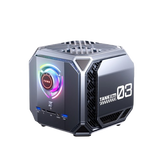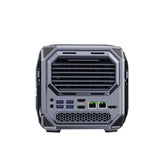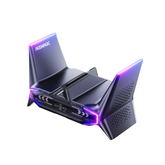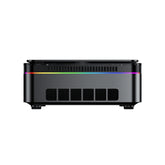Master Keyboard Shortcuts: Boost Productivity on Windows 11 & Browser

Knowing how to efficiently use keyboard shortcuts in daily operations can significantly boost your productivity, reducing reliance on the mouse and enabling you to perform tasks quickly. Here, I'd like to share some tips for using keyboard shortcuts on a Windows 11 PC.
Basic Shortcuts
Mastering some basic shortcuts can greatly improve your efficiency when working on your computer. Here are some commonly used shortcuts and their functions:
| Shortcut | Function | Description |
|---|---|---|
| Ctrl + C | Copy | Copies selected text, files, or folders to the clipboard. |
| Ctrl + X | Cut | Cuts the selected content to the clipboard, removing it from the original location for easy pasting elsewhere. |
| Ctrl + V | Paste | Pastes the content from the clipboard at the cursor's location. |
| Ctrl + Z | Undo | Reverts the last action, restoring the previous state. |
| Ctrl + Y | Redo | Redoes the action that was undone, reinstating any changes that were reversed. |
| Ctrl + A | Select All | Selects all content within the current window or document. |
| Windows + L | Lock the PC | Instantly locks the computer and returns to the login screen to protect personal information. |
| Alt + Tab | Switch Apps | Quickly switches between open applications. |
| Windows + D | Show Desktop | Minimizes all open windows to directly view the desktop. Pressing again restores windows. |
New or Improved Shortcuts (Exclusive to Windows 11)
Windows 11 has introduced some new shortcuts and improved existing ones to enhance the user experience. Below are some of the unique shortcuts available in Windows 11:
| Shortcut | Function | Description |
|---|---|---|
| Windows + W | Open Widgets Panel | Instantly opens the Windows 11 Widgets panel to view real-time information like news and weather. |
| Windows + A | Open Quick Settings | Accesses frequently used system settings like volume, brightness, Wi-Fi, and Bluetooth for easy adjustments. |
| Windows + N | Open Notification Center | View all your notifications and calendar events for easy management of reminders and schedules. |
Multitasking Shortcuts
Here are some essential multitasking shortcuts and their functions:
| Shortcut | Function | Description |
|---|---|---|
| Windows + Tab | Task View | Opens Task View to display all open windows and virtual desktops, facilitating task management. |
| Windows + Ctrl + D | New Desktop | Creates a new virtual desktop, helping you separate different workspaces. |
| Windows + Ctrl + Left/Right Arrow | Switch Virtual Desktops | Quickly switch between created virtual desktops to move seamlessly between tasks. |
| Windows + Ctrl + F4 | Close Current Desktop | Closes the current virtual desktop, moving open windows to the previous desktop. |
Utilizing these shortcuts, you can effectively organize and manage multiple tasks. Virtual desktops allow you to create independent spaces for different projects or work environments, reducing clutter and boosting focus. By quickly switching and managing these desktops, your workflow becomes smoother, avoiding cumbersome mouse operations and enhancing overall productivity.
For example, you can work on office documents on one virtual desktop while browsing the web for research on another, without opening too many windows on the same desktop. Using Windows + Ctrl + Left/Right Arrow, you can switch between these desktops quickly, keeping your tasks orderly.
File Management Shortcuts
Efficient file and folder management is a crucial aspect of boosting productivity in daily operations. The following are some commonly used file management shortcuts to help you perform file operations quickly, saving you time:
| Shortcut | Function | Description |
|---|---|---|
| Windows + E | Open File Explorer | Instantly opens a File Explorer window regardless of the application you're currently using, making it easy to access your files and folders. |
| Alt + Enter | View File Properties | Opens the properties window for a selected file or folder, letting you view details like size, location, and security settings. |
| F2 | Rename Selected Item | Allows you to rename a selected file or folder quickly without needing to use the context menu. |
| Ctrl + Shift + N | Create New Folder | Quickly creates a new folder in the current directory, named "New Folder" by default, for immediate sorting and organizing. |
Usage Examples:
- Quick Access to File Explorer: When you need to open or search for a file, press Windows + E to open a new File Explorer window without having to minimize current windows or return to the desktop.
- View Detailed Information: To view detailed properties of a file, such as modification date or permission settings, select the file and press Alt + Enter to bring up the properties window immediately.
- Convenient Renaming: When organizing files, select a file and press F2 to directly input a new name, making it particularly efficient for processing multiple files in succession.
- Fast New Folder Creation: When you need to categorize files, use Ctrl + Shift + N to quickly create a new folder without searching for the new option in the context menu.
Application Operation Shortcuts
In daily computer use, knowing shortcuts specific to certain applications or situations can help you manage applications and system status more efficiently. Here are some common application operation shortcuts:
| Shortcut | Function | Description |
|---|---|---|
| Alt + F4 | Close Active Window | Closes the currently active window or application without needing to click the close button with the mouse. |
| Ctrl + Shift + Esc | Open Task Manager | Directly opens Task Manager to view system performance, running processes, or end unresponsive applications. |
Usage Examples:
- Quickly Close Applications: When you're done using an application, press Alt + F4 to close the window immediately without moving the mouse to the close button—especially handy for full-screen apps or games.
- Manage System Processes: If your computer slows down or an application becomes unresponsive, press Ctrl + Shift + Esc to quickly open Task Manager. This allows you to check CPU and memory usage and end unresponsive tasks to restore system performance.
Browser Shortcuts (Using Microsoft Edge as an Example)

When browsing the web, using shortcuts can greatly increase your efficiency in opening, closing, and managing tabs. Here are some common browser shortcuts, using Microsoft Edge as an example:
| Shortcut | Function | Description |
|---|---|---|
| Ctrl + T | Open New Tab | Opens a new blank tab in the current window to start new browsing activities. |
| Ctrl + Shift + T | Reopen Closed Tab | Reopens the most recently closed tab; can be used multiple times to restore several tabs in the order they were closed. |
| Ctrl + W or Ctrl + F4 | Close Current Tab | Closes the currently selected tab, helping you quickly organize and clear unnecessary pages. |
Usage Examples:
- Open a New Tab for Searching: When you want to open a webpage or perform a new search in a new tab, press Ctrl + T to create a new tab without moving the mouse to the tab bar's "New Tab" button.
- Restore Accidentally Closed Tabs: If you accidentally close an important tab, pressing Ctrl + Shift + T will reopen it immediately, saving you the effort of finding the page again. This shortcut can be used repeatedly to restore several closed tabs in order.
- Quickly Close Tabs: After finishing with a webpage, you can press Ctrl + W or Ctrl + F4 to close the current tab without moving the mouse to the tab's close button, making it very convenient when you want to quickly clean up browser tabs.
Tip: These shortcuts are usually applicable across most browsers such as Google Chrome and Mozilla Firefox, allowing you to maintain consistent habits across different browsers. You can find more shortcuts or customize them in the browser settings to suit your preferences.
Shortcut keys for common browsers:
- Chrome Browser: Chrome keyboard shortcuts
- Microsoft Edge Browser: Keyboard shortcuts in Microsoft Edge
- Firefox Browser: Keyboard shortcuts - Perform common Firefox tasks quickly
- Safair Browser: Keyboard shortcuts and gestures in Safari on Mac
Additional Browsing Shortcuts
Beyond the commonly used tab management shortcuts, here are some additional shortcuts to further enhance your browsing efficiency:
| Shortcut | Function | Description |
|---|---|---|
| Ctrl + Tab | Switch to Next Tab | Rotate through tabs in the current window from left to right. |
| Ctrl + Shift + Tab | Switch to Previous Tab | Navigate tabs in the current window from right to left. |
| Ctrl + D | Bookmark Page | Add the current page to your favorites for quick future access. |
| Ctrl + L or F6 | Focus Address Bar | Quickly moves the cursor to the address bar for entering URLs or search queries. |
| Ctrl + H | Open History | Displays a list of recently visited pages for easy reference and access. |
| Ctrl + J | Open Downloads Manager | Displays a list of downloaded files for managing and accessing downloaded content. |
FAQs
How do I reopen a recently closed browser tab?
To reopen a closed browser tab, press Ctrl + Shift + T. This action will restore the last closed tab, and you can repeat this shortcut to reopen multiple closed tabs in the order they were closed.
How can I quickly shut down my Windows computer?
You can shut down a Windows computer by pressing Alt + F4 when you're on the desktop. This opens the shutdown menu where you can select "Shut Down.
What does Ctrl + F do?
Pressing Ctrl + F opens the "Find" function in most applications and web browsers, allowing you to search for specific text within the document or web page.
Final Thoughts
Using shortcuts not only saves time but also makes operations smoother, enhancing the overall user experience. We recommend that you first memorize the most common shortcuts, such as copy, paste, and window switching, and practice them regularly to develop muscle memory. Once you master the basics, gradually learn more advanced shortcuts like those for multitasking and file management to further improve efficiency.
What's your favorite shortcut? Have you encountered any challenges or interesting experiences when using shortcuts? Feel free to share your thoughts and questions in the comments section so we can learn and improve our productivity together!
See also
How to Use Keyboard Shortcuts on Your ACEMAGIC Laptop with Windows 11






